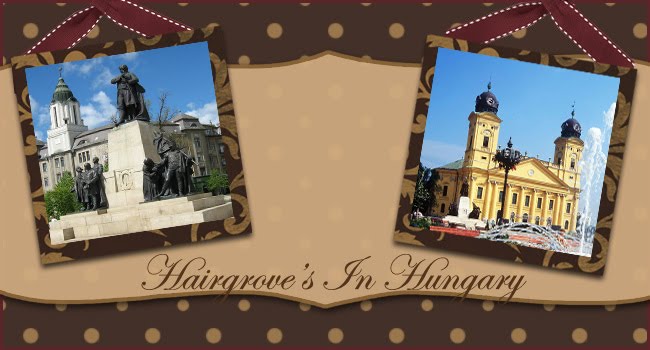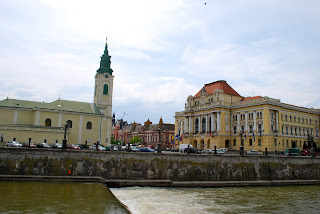If you live on the Eastern side of Hungary like we do, then you should probably visit the Transylvania Region/Romania at least once. We signed up to go through our CETP group--it is much easier to travel in this region with a travel guide.
We traveled with other teachers in our program, who have also been teaching in Hungary. It was great to reunite with old friends and meet some new people as well. The thing I worry about the most when traveling in a group is if I will get annoyed with the other people on the trip. Sounds silly, but if your trapped on a bus with people you don't like it could be a really long 6 days. Luckily this was not the case--everyone on the trip was great (and no I'm not just saying that out of fear of someone from the trip possibly reading this).
The great thing about Debrecen is that we are only about 45 minutes from the border to Romania. So the initial getting to Romania part wasn't so long. Crossing the border took a little time because they had to process all of our passport (around 20 minutes). After that our first stop was to Nagyvarad (Oradea), where we saw a catholic cathedral and did a short sightseeing tour of the center of town. The buildings in town are in the art nouveau style--a common site of Hungary and Romania.
 |
| The bus we traveled in during the tour. |
 |
| The cathedral. |
 |
| King Ladislaus I |
 |
| King Ladislaus I |
 |
| The cathedral. |
 |
| Tram to downtown. |
 |
| Going towards downtown and government buildings. |
 |
| The Black Eagle Passage. |
The State Theatre in Oradea, which has performances in both Romanian and Hungarian. This Theatre was designed by the same architects that did the Debrecen Theatre.
 |
A famous cafe where Hungarian intellectuals past and present
still like to meet. |
Oradea is located just 12 km from the Hungarian border and has played a profound role in Hungarian history. The city was founded by King Ladislaus I in the 11th century. While the city prospered in the 13th century the city was practically destroyed by the Turks in the 15th century.
After being conquered and passed around by random princes and empires in the 15th and 16th centuries it started to regain its strength in the 19th century. It helped play a critical role in the Hungarian Revolution of 1848 by being the home of the largest arms factory while Debrecen was the temporary seat of the Hungarian government. Despite the loss of the Revolution Oradea continued to grow and gain nicknames like "the City of tomorrow," "Athens on the Körös," and "Paris on the River Pece."
However, after WWI the Treaty of Trianon awarded large parts of Eastern Hungary, including Oradea and Transylvania to Romania without considering the population of the region. Today the city still has a significant Hungarian population and is in the process of bridging its Romanian present with its Hungarian past.
After the tour of Oradea we traveled to the town of Banffyhunyad (Huedin) in the Kalotaszeg region. We visited a protestant church from the 12th century. The town of Huedin was founded in the Middle Ages and boasts a strong historical Hungarian heritage. In 1910 the town was 90% Hungarian speaking and today it is around 32%.
 |
| The Reformed church. |
 |
| The church has a unique ceiling design. |
 |
Many of the wood carvings help tell stories from the Bible
and are also related to zodiac signs. |
 |
| Embroidery is a skilled tradition passed down in this region. |
After the visit to Huedin we made our way to Kalotaszentkiraly (Sincraiu), where we stayed at a lovely Hungarian run hotel. But it really wasn't a hotel in the traditional sense, it was more like staying at someones really nice guest house.
 |
| The town of Sincraiu. |
 |
| Curious onlooker. |
 |
| Enjoying a delicious meal. |
As usual with any Hungarian meal the first thing that must be done is a shot of
pálinka. After stuffing ourselves with soup, a main course and dessert we were entertained with some traditional dancing.
 |
Showing the traditional outfits that used to be worn in this
region. |
 |
| Traditional dancing. |
After they showed the traditional dances they then asked us to dance with them. I was asked to dance---and maybe it was the pálinka or my last night of being 25, but I thought what the heck. I got swung around the dance floor, which made being a bit tipsy even more fun. It was hard to believe this was just our first day on the trip. We felt like we did so much that day, but each day gave way to new surprises.
 |
| The first of many dances to come on the trip. |
 |
| Our room for the night. |



























It was in fact the,quote: "considering the population in the region"the main reason why after ww1 the union of Transylvania with Romania decided by the representatives of all ethnicities living in the region,at the popular meeting in Alba Iulia on December 1st 1918,was recognised at Trianon.There were and still are around two million Hungarians in Transylvania and seven million Romanians.The numbers haven"t change at all.Unfortunately the one million German population that was living there at the time, was reduced after ww2 to a few hundred thousands due to deportations by the soviets and later emigration to Germany.Transylvania was and will always be the homeland of Transylvanians,no mater if their ancestry is Hungarian,Romanian,German,Jewish,etc.Best of luck from Romania.
ReplyDeleteThanks for your input. We agree that Transylvania is a multi-ethic region. Our tour was slightly one-sided because we had a Hungarian tour guide and stayed with Hungarian families. Thanks, Dana.
ReplyDelete